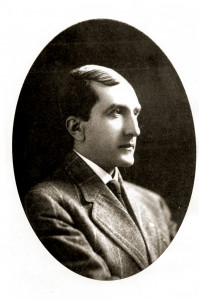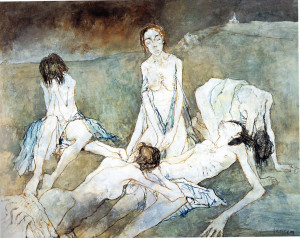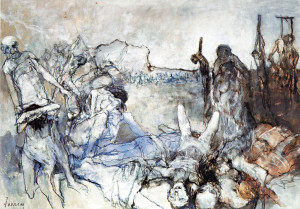Հայերեն | На русском | In English

 (Excerpts from HRANT TAMRAZYAN’s “Siamanto” monograph)
(Excerpts from HRANT TAMRAZYAN’s “Siamanto” monograph)
… Art must come from the life of the people and serve the people. The motto underlined in the 1880s, defended by Arpiaryan, Zohrap and others, acquires a special significance, almost fatal, at the beginning of the 20th century. This motto is continued and developed by Siamanto with a new force and purpose.
… Siamanto’s “Song of the Knight” is a strong and dramatic work, an influential description of pain and power. Siamanto creates the romantic image of a knight, an Armenian hero. The song, on the one hand, restores the history of the bloody days, on the other hand, expresses the thoughts of the child of the country about the fate of the homeland. The knight wanders through the native fields, the birthplace, the ruined cities and villages, through the mass graves, he wanders towards the goal of lighting the torches of hope, to join the rebels of the country. It passes through the native paradise shores, with streams, bleeding the memories of childhood, but suppresses the longing. He passes by graves and white tombs, the ashes of burnt cities, but restrains sorrow, suffocates love, tears.
“The Song of the Knight” on the one hand opens the pages of the history of suffering, on the other hand – the idea of living, fighting, saving the land. Give up crying, useless tears, old sighs …
 The “Song of the Knight” sounds the instruments of rebellion of the forces “loaded with justice”, becomes a heroic invitation to the struggle for life …
The “Song of the Knight” sounds the instruments of rebellion of the forces “loaded with justice”, becomes a heroic invitation to the struggle for life …
In a number of poems, Siamanto creates the magnificent romantic image of a meeting of a poet and a hero, a poet and a warrior, brothers of suffering. Here is a vision full of sad thoughts. The poet is alone with his thoughts (“I want to die singing”). He thinks about the fate of the homeland. “And I would weigh the fortune of the homeland with a bowl of trial and suffering” … in the middle of the night, with dreams of waiting and hope. The lone poet is like that in the bright lights of day, because the world around him, the foreign land and the sky say nothing to him, his mind is fixed on one point, the homeland. The vision changes, the poet’s peace խաղաղ peaceful process of thought gives way to strength and beauty, the poet is with a patriotic warrior.
He was young.
The poet and the soldier … The mind and strength of the people, the thought and the will, the feeling and the goal – with these features the poet and the soldier, the martyr of thought and the martyr of war, or rather the hero of thought and the hero of the battle, face each other. What subtle comparisons Siamanto forms with the poet and the soldier, side by side, with the same thoughts and smiles, but with a different structure. One is as dull as a morning dream, the other with a thoughtful head resembling the bloody heart of a demigod, one with soft reflections, the other with the celestial spark in the eyes of the stars. Both are looking for the symbol of the homeland …
They understand each other, they feel each other, the pain has made them sensitive and delicate, the pain has united the children of the people, it has made them super-sensitive …
The poem, full of sadness and grief, gets a new emphasis, the heroic one is born from sorrow. The soldier brings the poet the steely word of faith and farewell.
My horse is already saddled with life and fight
the fever will roar in front of your door …
And behold, my innocent sword is naked,
nakedness to superhuman judgments.
Bring your forehead to my lips … to faith and
It’s my farewell evening, friend.
The poet is again facing the people’s will. The word of the soldier, the message to the translator of his soul, to the prophet, to his brother sounds colorful and expressive.
***
 Siamanto was on a new creative path, living with new love and dreams. But very soon the Armenian sky darkens, on the eve of World War II, the active activity of the Young Turks creates an alarming situation in the country, the political atmosphere becomes threatening. World War II begins, the Turkish government calls for the mobilization of Armenians between the ages of 20 and 45. Relatives reach out to Siamanto to release him from Turkish conscription …
Siamanto was on a new creative path, living with new love and dreams. But very soon the Armenian sky darkens, on the eve of World War II, the active activity of the Young Turks creates an alarming situation in the country, the political atmosphere becomes threatening. World War II begins, the Turkish government calls for the mobilization of Armenians between the ages of 20 and 45. Relatives reach out to Siamanto to release him from Turkish conscription …
In those troubled days, the poet could have easily freed himself, but, like other prominent intellectuals and writers, he remained with the people. To complete the honest civil description of Siamanto, it is not superfluous to bring a telling fact. Hearing about the alarming situation of Armenians in Switzerland, he returned to Constantinople to share the fate of the native people. Av. Isahakyan’s memory written by literary critic Aram Inchikyan speaks about that. “Once the Master, experiencing with deep sorrow the terrible loss of Siamanto, Zohrab, Varuzhan and and other friends, remembered with regret that in 1914. At birth, Siamanto did not listen to his advice not to return to Constantinople.
– I have to go, my people are there …
“He left, he fell into the beast’s mouth,” the Master added after a sad pause.
… The Turkish government, by joining Germany, was secretly working out criminal plans. The Armenian intellectuals and the whole nation lost in the snares of the young Turks did not yet understand the meaning behind the conscription of the Armenians. In fact, the Turks were cleansing Armenia of fighting forces, completely disarming the people. The Germans set a crucial task for the Armenian political parties: to adopt a German orientation, to join the war against Russia. Armenia was between two fires, he could not do the impossible. The people could not go against Russia, with whose people they were spiritually connected, under whose rule Eastern Armenia was. Any kind of decision could put him in front of a national catastrophe.
The bloodthirsty Turkish statesmen Enver, Talaat and others, carrying out their monstrous plan, considered the annihilation of the whole nation a vital necessity for Turkey, justifying the Armenian massacres with impudent sincerity. Here are their thoughts. “Armenians are the cause of all their evils”, “We will fight for our national existence”, “We had the right to resort to all means that could achieve our goals”, “We do not have time to separate the innocent from the guilty”. In an interview with a German reporter, Talaat, under whose shadow all the medieval inquisitors are praying, says with surprisingly peaceful sadism: “They say in our face that we did not differentiate between innocent ‘criminal Armenians’, that was absolutely impossible, because today’s innocent people will be tomorrow’s criminals.” With the same sincerity and undisguised arrogance, Talaat was proud of Talaat’s solution to the Armenian question. “I saw more work to solve the Armenian issue in three months than Abdul Hamid in 30 years.”
This was the real reality, even according to the testimony of bloodthirsty Turkish figures, the leaders of the Young Turks.
Numerous facts prove that for many years the Young Turks incited the ideas of Pan-Turkism by sowing hatred towards the peoples living in Turkey. Inspired by the idea of a great Ottoman empire, they planned to assimilate the Muslim faith and physically exterminate the Christian people. The young Turks, the representatives of the interests of the bloodthirsty Turkish bourgeoisie, dreamed of reaching the borders of their empire to the Volga, conquering the whole Caucasus, Crimea. Even before the war, they sought to serve the Muslim peoples of the Caucasus, and inside the country, using every opportunity, they set small nations on fire. 1913-1914 On the eve of the bloody massacres, they offered the Armenians to organize a volunteer movement against Russia in order to make the massacre of Armenians bilateral. In short, they planned to annihilate not only the Armenians of the western part, but also the Russian-Armenians on the other side of Ararat. Germany was Turkey’s direct advisor and ally in that issue. Thus, for example, the ideologue of German militarism, Rohrbach, in his reports and articles developed the idea that the gradual annihilation of the Armenians was beneficial for Turkey.
And so, by internal military agreement, Turkey and Germany “decide” the Armenian issue, choosing the means of mass massacres and deportation. Maturing events became catastrophic. The days were coming that Siamanto was warning about with deep insight.
Hurry, I am for you, because all lives
will be crushed,
All the wicked shall be widows, and all widows shall be widows
will die
All newborns in their diapers
under the bloody folds,
The eyes unaware of their life in death
they have to open …
Siamanto’s words against the insidious policy of the great imperialist powers were justified.
Shoot while sleeping on the sea
warships are foreign
Do not sleep in the depths of justice!
wake up for a minute.
Siamanto’s insight was justified. 1915 in April, under the cold eyes of European powers, Turkish and German militaristsThe lies begin the annihilation of the Armenian people. Once again the people take the paths of alienation, endless rows of Armenian orphans, old men and women stretch out in the hot deserts. First of all, the Turkish government, of course, decides to behead the people, that is, to draw the sword of the intelligentsia. On the night of the April 24 genocide, 210 intellectuals were imprisoned, including Siamanto, Varuzhan, Zohrap, Komitas, Ruben Szak, Tlkatintsi, Otyan, Yerukhan, Zardaryan, Tigran Cheokyuryan, Melkon Kyurchyan, exiled, their mother-in-law were exiled. , the child, the hearth is destroyed, the heat of the “noble cities set on fire” rises, an ancient homeland is removed from the map of the world, the imperialist policy is swallowed up by a people stuck in the crossroads of history, a careless treasure hunter is trapped in the desert. Hungry children, savage Turkish-Kurdish bandits exterminate defenseless people on the orders of the Turkish government. The Armenian poet, who wished the world peace, sees the scattered ranks of the children of the people, caught east, west, north and south … And yet, even in this moment of disaster, in the eyes of the horror of death, the Armenian mother teaches Armenian children on the sands of the desert The writing, the Mesropian letters … What a tragedy, and at the same time, what a great vital force in the people who, nevertheless, looked to the future with inner faith, wanted to live, lived …
The Armenian intellectuals are transferred to the village of Ayash in the Ankara province, the other part to the city of Chanker. 1915 On May 1, Siamanto was already in Ayash prison …
Witnesses left shocking memories about the fate of Ayash prisoners. Some of them are brutally looted on the Urfa-Tigranakert road. The prisoners left in Ayash are divided into two parts. A group of people, including Siamanto, with a caravan of 1,200 people, are apparently brutally ravaged in a gorge 4-5 hours away from Ankara in late August. at the foot of Peli Mountain. The Turkish police, united with the blind and fanatical crowd of the locals, literally torture the dying people, loot the bodies, and scrape the wounded with needles. The mortals were demanding death from the criminals, and the Turkish mob, the criminals released from prisons, were still torturing the victims with axes, stones, iron rods and shovels. The “sacred jihad” was attended by ardent villagers, criminals, police, ministers and thinkers with European education.
It goes down at night. Wild beasts continue to feast on the blood of Turkish barbarians and prehistoric savages. And in the morning the Turkish murderers were walking in the streets of Ayash and in the streets of Ankara, decorated with European costumes and the clothes of the Armenian martyrs. Visions of torment and death, nights of bloodshed and destruction, evenings of carnage and “rest” – these are the stories of the Armenian-Armenian people in the age of civilization, the last pages of their sufferings, which Siamanton, with astonishing foresight, foretold to create Siamanto with his painful calamity. The true picture of suffering and fate.
With a cruel game of fate, Siamanto’s mourning songs came out surprisingly like images of his own fate, the destruction of his people.
Siamanto’s songs became a monument to his unfortunate fate, his work still retains its cognitive significance, remains the deep artistic history of national days of suffering, blood and suffering, the infallible mirror of the relentless truth of our recent past.